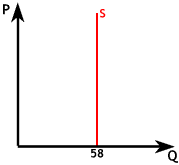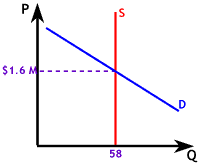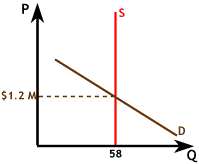
Why would advertisers pay so much for commercial air time during the Super Bowl? In the most general sense, the sheer fact that companies are willing to pay this amount means that they believe the ads are worth at least $1.6 million (some spots may sell for as much as $2 million). A basic economic principle we can always rely upon is that the purchase of a product or service is proof that the buyer values the purchased item at least as much as the amount paid.

We know that market price is determined by the interaction of supply and demand. The supply of commercial air-time for ads during the Super Bowl is, essentially, perfectly inelastic. The only way Fox could sell significantly more commercial time would be if the game went into overtime (and advertisers always reserve commercials for this time in case it happens). Fox has 58, 30-second commercial blocks it can sell for the regular game no matter what price advertisers are willing to pay. Graphically, we show this as a vertical supply curve as shown to the right.

Advertising during the Super Bowl offers some unique advantages over any other TV event. The most obvious is that the game draws a huge viewing audience each year, typically the highest rated show of the year. A large proportion is made up of relatively young, affluent consumers (i.e. consumers who buy lots of stuff). Even more importantly from the advertisers point of view, much of that audience is male. Studies show that men watch less television than women so it is harder for advertisers to reach them, therefore the Super Bowl is an excellent opportunity to reach a large male audience. Equally important though is that the Super Bowl has become famous for the more creative, more original commercials that run during the game, enough so that some people watch only for the commercials and almost half of all viewers say that the commercials are part of the reason they watch. This means that advertisers can count on a greater proportion of the audience actually noticing their commercial rather than leaving the room, channel surfing, muting the TV or any of a number of strategies consumers typically use to ignore ads. Given all these reasons, the demand curve intersects the supply curve such that the equilibrium price is at least $1.6 million per commercial, as shown to the left.

Because supply is inelastic, as demand for commercials aired during the Super Bowl increases only the price of the commercials, not the quantity, rises. Revenues from Super Bowl TV commercials increase each year while the total supply of commercials stays almost unchanged. As the graph to the right shows, when supply is perfectly inelastic, shifts up in demand lead to an increase in price only, while the quantity remains unchanged.
Before we feel sorry for the Fox network because it faces an inelastic supply curve for commercials during the game, and thus a limit on its profits, let's remember that they can also sell commercials for the Super Bowl pre-game show, even if they can't charge $1.6 million each. This year, the Super Bowl pre-game show runs for 7 hours! Apparently the supply of pre game commercial spots is somewhat more elastic.

During the game itself, Fox will earn revenues of over 90 Million dollars, shown as the green rectangle to the right (the area of this rectangle is 58 x 1.6 million = 92.8 million). Remember, however, that revenues aren't the same as profit. Profit is revenues minus costs, so the profit earned during the game will be much less than 92.8 million. Though, given the earnings from the 7 hour pre-game show, we can feel secure in the knowledge that Fox isn't loosing money on the Super Bowl. In fact, it predicts that today will be its most profitable single day to date, earning the network over $150 million. Finally, Fox can use such a high profile event to advertise other shows, particularly those it believes will appeal to a male audience, thus increasing viewing and advertising revenues on those shows in the future.
Copyright © 1995-2003 OnLineTexts.com, Inc. - All Rights Reserved